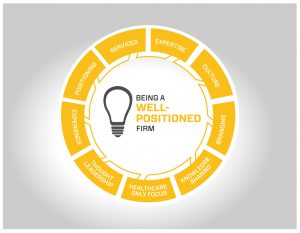I am often asked my thoughts on where I see Array’s practice five years out, causing me to reflect on from where the firm has come. Our founders were once part of the design arm of one of the pioneers of for-profit health systems. So, as a 30-year-old design firm focused solely on the healthcare market, our practice has always been rooted in a deep understanding of our clients’ business practices. But it has only been in the past five years that Array has invested deeply in distributing and dispersing organizational knowledge to enhance a deeper understanding of our clients’ business models for the purpose of creating differentiating value for their long term success.

The firm’s transition to a culture that embraces knowledge sharing as a vehicle to provide enhanced value to our clients has been an interesting journey – a journey that I see continuing to define a large part of Array’s business strategy well into (and beyond) the next five years. At Array, we believe our pursuit of knowledge excellence and continuous improvement is critically important to the growth and evolution of our practice, and crucial to the delivery of successful outcomes for our clients.
As the business leader for Array, I am tasked with developing and implementing business strategies that will sustain the practice well into the future. Years ago, as I surveyed the landscape of the healthcare design market in which we practice, I saw our margins being compressed, and our ability to create differentiating value to our clients diminishing. These signs were clear indicators that we were well immersed in a fee based market – a market where it becomes increasing difficult, if not impossible, to deliver innovation and creativity at levels our clients expect from their healthcare designer, or to attract and retain the talent needed to deliver that value.
What we saw was an industry that was rapidly moving from a service-based to a knowledge-based economy where one of the key characteristics is the separation of the production and consumption of services. The use of technology in the A/E industry is advancing that separation. Overlaying components of a knowledge-based economy on the structure of today’s design firms reveals stark similarities. These components being
• Information and Communication Technology
• Open Innovation
• Education
• Knowledge Management
• Creativity
Our culture of continuous improvement has allowed us to develop streamlined processes and workflows to deliver projects more efficiently. This gain in efficiency has allowed us to improved our margins to increase investment in our knowledge assets, while also allowing us to continue offering fees that are competitive in the marketplace. But simply improving internal workflows does not necessarily deepen a culture of innovation where real value and sustained long-term value for our clients, can be created. Array understands that our clients expect competitive fees, but we also know that what they seek in their healthcare designer and what their projects need more than anything else from their design team is innovation and creativity to drive solutions that create long term, sustainable value;
• value that is measurable well past the final punch list
• value that is measurable well into the entire life cycle of the building
• value that presents itself as enhanced and improved operational efficiency for the facilities Array helps to create
In a fee-based market, it is not possible to deliver the kind of value that has, as its foundation, innovation in either process or solutions. There are simply not the resources available to the design professional to do this. However, it is not unreasonable to expect our clients to hire their healthcare designers based on anything but fee unless we can articulate and demonstrate other reasons that create value for their projects.
Interestingly, our healthcare clients are experiencing a similar transformation with healthcare reform replacing the age-old “fee for service” payment model with a “value-based” payment model. Patients and their insurers are expecting results and positive outcomes in return for payment, and the leaders at Array understand that our clients expect the same from those who provide services to their organization. So investing in, and executing strategies around assembling, distributing and disbursing organizational expertise and knowledge to enable Array to deliver on our value proposition, will continue to be an emphasis for Array.
The A/E industry is one where the link between knowledge management and business strategy is often discussed, but is widely ignored in practice. Knowledge sharing, both internally and externally has become an integral part of Array’s DNA and culture. We think it has had a significant impact on our ability to provide differentiating value for our clients and their projects.
That investment thus far has resulted in a very robust platform where our staff are sharing project experiences (both successes and opportunities) and industry trends; a platform where staff seek out solutions and expertise from fellow healthcare designers across our six offices, all driven by the shared core value of continuous improvement. This platform and organizational structure has also allowed us to evolve our delivery process into one that many clients are finding makes a difference in creating successful project outcomes.
Array understands that our practice, at least in the foreseeable future, will thrive or fail by demonstrating mastery of sought-after services – services that result in value for our clients. Array’s continual pursuit of process improvement steeped in knowledge excellence, while certainly part of our business strategy, has at its core the delivery of successful outcomes for our clients. At the conclusion of a each project we ask ourselves, did Array’s process and people help to contribute to successful outcomes and did these outcomes translate to value for our client and their project. If we can answer in the affirmative, we have demonstrated Array’s value proposition.
(Please click ‘well-positioned firm’ graphic to link to Rattleback’s recent post on 5 Examples of Well-Positioned A/E Firms.)





